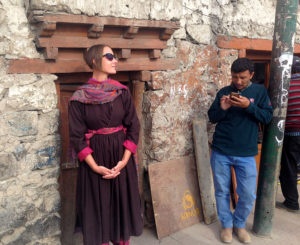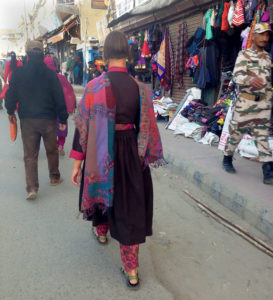Gunzang is the wife/mother of the household where we were staying in Leh. It took a lot to make her smile sometimes. She only spoke a very small amount of English so I think the language barrier made her uncomfortable, which is understandable. Most of our conversations resulted in her saying “OK, OK” but we were fairly certain that she had no idea what we were saying. One night we were hanging out with Sid and, with the help of his translation skills, Fern got the point across to Gunzang that she really liked Gunzang’s clothes.
I happened to know from previous conversations that what Fern really liked was the south Asian style of shirt or dress that many women wear. It usually has a half or 3/4 length sleeve and comes down to about the knee with a slit on both sides coming up to the waist, and it’s often made of a light airy cotton but the fancier ones are usually shinier synthetics or possibly silk. Baggy pants are worn underneath it. They frequently have embroidery and very bright colorful patterns but they can just as easily be of a simpler design. Despite the ornate quality they are essentially a conservative way for a woman to dress that is also very comfortable. The cut is flattering and feminine but it covers a lot of skin that westerners are accustomed to showing and it’s loose enough that it doesn’t draw attention to every little curve. Gunzang wore one of these shirts with the baggy pants pretty much all the time when she was at home.
When Fern expressed her appreciation for Gunzang’s clothes she lit up and got excited. This was the most excited I’d ever seen her and she even let a good number of big smiles out. She didn’t quite understand, however, that Fern was mostly into Gunzang’s typical, everyday, around-the-house dress. She disappeared for a few minutes and then returned with a bundle of clothes in her arms. What she brought out was her traditional Ladakhi dress, worn by some women (mostly older women) all the time but for others, like Gunzang, it was something she wore at social or family gatherings and religious occasions (of which there are many).
This was the summer dress and it consisted of a dark brown heavy wool over-dress that buttoned up to the neck and came down almost to the ground. There were baggy pants that went with it, a sash for the waste, and a colorful shawl that needed to be worn in a specific way. Gunzang was in a frisky mood that evening and she suggested that Fern try on the clothes. Why not? She put the dress on over her clothes and Gunzang tidied her up with the other accessories. Fern was taller than Gunzang so the sleeves were a little short and the dress didn’t come down quite as far as it should have over her legs but it was passable and we all got a big kick out of it, especially Gunzang.

Next Gunzang suggested something that came as a bit of a surprise. She thought Fern should wear the outfit around town, like when we walk to the town center for dinner or shopping. Not only that, but she also brought out one of Tsering’s (her husband’s) traditional outfits, which I had never seen him wear even once, and thought I should wear that. I suppose Fern was feeling frisky too and she said she would and seemed excited about it. I accepted the possibility in an ambiguous and non-committal way. I would probably feel more comfortable wearing a Ronald McDonald costume around town.
It wasn’t that it looked bad, because it didn’t. It may be a little hard to grasp for many Americans, for whom the word “tradition” means camping out in a Wal-Mart parking lot on black Friday to buy the latest gaming system for a Christmas present. Tradition is the very core of identity for many people, especially in India. It differentiates them and makes them proud. It provides various status symbols on which the social fabric is woven. When people immigrate to the United States many of their traditions are lost within a couple of generations. Here, in India, pockets of people have been doing things the same way for many hundreds of years. They never disconnected from their motherland. Tradition is extremely important to them and Gunzang was suggesting that we have a little fun with it and flaunt it around town. At least she would get a good laugh out of it.
Each day as the intense high-altitude sun warmed things up, the idea of walking around for a few hours in a heavy wool dress became less and less appealing but Fern was determined to do it. Toward the end of our stay we knew that time was running out and Fern mustered the courage to put on the outfit. We needed to go for a long walk across town to enquire about some bus tickets. I declined to wear Tsering’s clothes, opting instead for shorts and a tank top. Fern may have been a little nervous but this was going to be a fun little adventure so she went ahead with it.
We set out toward the town center and within about ten minutes we saw Tashi, the elder of Gunzang’s sons, walking home on the other side of the road. He saw us too and was overcome with a huge smile. He started jumping up and down and it looked like he was about to explode. It so happened that he was present the night that Fern first tried on Gunzang’s clothes and he knew about the whole plan of walking around town in those clothes, I just don’t think he was ever expecting to actually see it happen. This was a situation that just didn’t quite make sense, like a couple of wires got crossed in his brain. Here was Fern, walking down the road that Tashi grew up on, wearing his mother’s formal clothes. We waved to Tashi and continued on our path. Our journey to the bus station took us through the main bazaar in the center of town which included an area full of tourist oriented shops as well as an area primarily frequented by locals. Fern got a LOT of attention on that walk.

The tourists barely noticed. Tourists in India, and many other places, feel free to dress in ways that they would never dress at home so seeing a white person dressed in a peculiar fashion is nothing unusual. The locals, however, definitely noticed. Most of them stared at her. They didn’t just glance over at her but they gave her a long hard look and many of them let her know what they thought either verbally or with their facial expressions. The pressure of so many people staring at her, many with a look of obvious disapproval, became almost unbearable after a while. Fern gets a lot of looks as it is, especially because of her tattoos but this was a whole new kind of social scrutiny. Due to this pressure Fern naturally recoiled mentally to an inner place, still walking around physically but almost in a trance, trying to disconnect from her surroundings.
A few distinct groups had their own kinds of reactions when they saw Fern. The best were the older men. They have a traditional style of their own and they always seem to be loitering about smoking cigarettes on the street. Trousers, earthy but finely made wool vest, long sleeve button up shirt, traditional Ladakhi hat with colorful embroidery around the front. It’s conservative, almost a little preppy, and strangely urban. They seem to have an enormous amount of free time and are obviously entertained as they watch the world go by. When they saw Fern many of them were impressed and amused, and they weren’t shy about telling her. They’ve been looking at Ladakhi women dressed this way their whole lives but here was something fresh and new. They had smiles on their faces and complimented her.
Hoards of teenage girls were wandering around in search of after school sweet treats and had a reaction upon seeing Fern that one might expect from hoards of teenage girls. They looked as if they had just seen some sort of carnival freak show. They pointed, giggled, whispered to each other, and had a look of combined embarrassment and disgust. I could almost hear their thoughts “Like, oh my god, can you believe what she’s wearing? What a freak. She looks like my cranky old Grandmother. Gag me with a spoon.” Fortunately nobody gives a shit what teenagers think and it was pretty easy to disregard their foul energy despite their large numbers.
Many younger adult women as well as a few men, and by younger I mean up into their 40’s, gave Fern a look of approval and even appreciation. To them this was one of many ways that a woman could dress. It was an expression of style. To see a western woman choosing to present herself this way was a compliment to the material beauty of their culture. These women, exposed to other more modern Indian styles and international styles, are faced with decisions about how to dress all the time just like anyone else in their prime who cares about looking stylish. They wear plenty of styles that come from our country and now they get to see an American wearing something traditional from their country. At the very least I think many of them found it interesting and many people complimented Fern.
Then there were the older women. This was their tradition that Fern was messing around with. She was dressed exactly the same way that they were dressed. The majority of them looked at her in horror, shaking their heads, insulted by this imposter posing as one of them. I don’t think anyone actually spat on her but it wouldn’t have surprised me. My overall impression of older Ladakhi women, as a generalization that certainly isn’t true 100% of the time, is that they are a serious and somber bunch, not nearly as light-hearted as the older men. I don’t know why this would be the case. Maybe they work harder than the men, weathering harsh environmental elements for decades to maintain a household while the men work for a few years to earn money and then spend the rest of their years standing on the sidewalk smoking cigarettes and drinking tea. Maybe they mourn a bygone era when the air and water were cleaner and children respected their elders and paid attention to the proper ways of doing things. I don’t know what burdens weigh on the minds of these women but they don’t look too thrilled by the state of things and seeing Fern dressed this way struck an offensive chord inside them. I think this was the most difficult part for Fern.

The combined effect of all this attention after a couple of hours started to wear Fern down. She needed to get off the street and get out of those clothes ASAP. We took care of our errand at the bus station and hurried home along a less populated route. Neither of us anticipated the intensity of this experience.
While it wasn’t Fern’s initial intention, this turned out to be an interesting social experiment. Once she calmed down and we both had time to process what had happened, like any good social experiment, it stimulated a lot of discussion. It made us think about issues which are present all the time whether we choose to consciously acknowledge them or not. What is the role and value of tradition? It obviously varies considerably even within a culture so there can’t be one right way to look at it. How much does it matter what other people think of us? Again, it changes from situation to situation, and Fern and I find ourselves in many new kinds of situations all the time.
Maybe the most obvious thing to me is something that we actually think and talk about fairly often. There is a hazy, ever-shifting, boundary between maintaining our own identities and being culturally sensitive in a foreign country. We are who we are. We have our own worldviews and lifestyles. Should we change those things just because we’re in a different country? On one hand – no. It would be silly to try to undo a lifetime of social conditioning. On the other hand, we will frequently have a richer experience traveling if we make a basic effort to adopt some local customs, or at least not offend the people around us, even though we may find ourselves doing things that seem absurd to us. To some degree that usually entails sacrificing a tiny piece of ourselves or at least our comfort. These tiny pieces may seem insignificant but how many tiny pieces can be spared? And is it always worth it?
It gets especially complicated when it comes to religion. Should we adopt other people’s religious practices even though we don’t share their religion? My naturally stubborn first reaction would be a resounding “hell no” but in reality it’s not that simple. For a huge number of people religion is not a separate little section of their private lives to be put in a folder next to things like business, family, community, or survival. It is a part of everything, which can feel very foreign indeed. If we want to see how people around the world live (which we do) or what makes various cultures tick, then religion cannot be ignored. I don’t have to like or agree with everything they believe and do but it does deserve a certain respect if we want people to engage with us and share their culture with us. Having said that, it’s not always clear just how far we should go. There are definitely times when I refuse to do something simply because it doesn’t feel right to me or maybe I don’t know the full meaning of the action and I personally find it to be disingenuous to perform a ritual without knowing its meaning.
Even if we fully embrace a place and its customs, is it possible to go too far? I think some of those older ladies in Leh would say so. It may be offensive to some people if we pretend we are just like them. Perhaps it belittles their culture to think that all we have to do is put on some clothes to understand them. Or maybe they feel that their culture is something they’re born with, that there is no choice in the matter. Here we are, privileged Americans, feeling free to try on different cultures for size as if we didn’t already have own of our own. Let’s just go down to the culture store and buy a new culture for the day!
There are few clear rights and wrongs in these situations. It really is all a matter of perspective. A paradox – that in some situations we can respect and appreciate people by doing as they do, and in others we can respect and appreciate them by not doing as they do. Who would have thought that a simple stroll through town in a Ladakhi dress would have such an impact on Fern or the people around her on the street. It was an experience that I’m sure she’ll never forget.

jim@snorkelbandits.com
